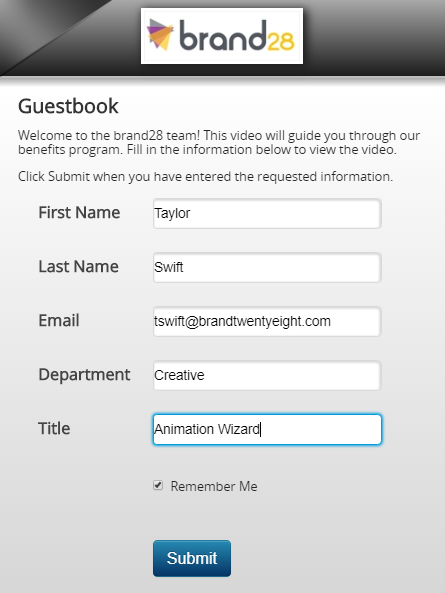3 Trade Secrets Revealed: How to Keep Your Onboarding Videos From Failing
According to the Society for Human Resource Management, 69-percent of employees are more likely to stay with a company if they experience a great onboarding process. They’re also 50-percent more productive.
Where do companies fall short?
● Poor communication after the offer is accepted
● Not being prepared for the new hire's first day
● Dumping too much information on the new-hire at once
● Not providing enough guidance and mentorship
● Boring new-hires to death
Onboarding videos as part of a holistic onboarding program will help you address every one of these shortcomings, but not without a little razzle-dazzle. Today, we’re sharing three trade secrets guaranteed to deliver real onboarding results.
1. Don’t Just Watch...DO!
The number-one mistake companies make is failing to strategize what they will do with their onboarding video once it’s completed.
TIPS:
Make The Video a Requirement
New-hires are scrambling to learn about their new work environment, which makes something as intangible as a video easy to push aside. Our most successful clients require new employees to watch their onboarding videos and enforce this requirement by asking employees to sign a form. If your video agency is tech-savvy (wink, wink) they can make tracking employee participation super easy. Check out an example of a “guestbook” we create for our clients to collect employee “attendance”.
Make The Video Easy to Access
Your new-hire isn’t just navigating a completely different physical working environment; they’re also figuring out a new digital network. In some cases, they may not even have user access to things like the company intranet yet. For this reason, we recommend hosting your onboarding video in more than one place and sending it via email, postcard, text, or chat on multiple occasions. No doubt, their inbox will be inundated with messages, and we all know how easy it is to pass up or accidentally delete an email.
Use Analytics to Improve Video Content
Internal communications isn’t an exact science. Your assumptions about what employees want and need may not be entirely correct or relevant months from now. Having insight into how much of the video employees watched, what parts of the video employees re-watched or skipped, and how well the video educated new-hires is vital to improving the efficacy of future video projects and enhancing the onboarding experience.
Pro Tip: The right video agency will act as your partner beyond production to analyze video performance and work improvements into your future video strategy.
2. Take the Boring Out of Onboarding
Employee engagement is every business’ Achilles heel. If you can’t engage employees right out of the gate, how will you keep their attention and motivate them for years to come?
TIPS:
Get to the Point
Between finding their way to the coffee pot, memorizing names, and learning about the demands of their new position, new-hires haven’t a minute to waste. Skip the formalities, forget the sugar-coating and give employees only the information they need right now.
Make the Video Interactive
Keep their focus throughout the video by embedding questions, links to additional video explainers, and tabs for easy access to forms, policy documents, SOP’s and more. In addition to improving viewership, interactive elements will help employees commit information to memory and bolster their ability to recall the information when needed.
Don’t Be a Robot
When was the last time elevator music and a mono-toned speaker got you jazzed about work? Never! We use conversational dialogue, energetic music, animation, and charismatic voiceover artists to have a little fun and create excitement around otherwise dull topics. Once again, these creative features support your employees’ ability to memorize and recall information. Plus, they make onboarding videos way more entertaining to watch!
3. Keep the Message Clear and Concise
By nature, video is a one-way conversation. However, that doesn’t mean we should disregard an employee’s experience of the exchange.
Don’t Use Industry Jargon
If you want your onboarding video to be evergreen, consider that not every new-hire has the same background. They may be, young and inexperienced or brand-new to the industry. As such, they will require extra clarity, especially around common industry language.
Keep Videos Short
We get it; you have a lot of information that needs to be communicated up front, but an information dump big enough to fill fifteen minutes of time will not result in your employee absorbing the data. The shorter the video, the more likely you will be to keep a new-hire engaged from start to finish. If length is a concern, consider pairing down the message or break up the content by creating a video series that can be watched in bite-size chunks over the course of several weeks or months.
Make Your Onboarding Video Searchable
Even the most engaged employee will struggle to remember everything that was offloaded to them during their first weeks of employment. To help make your video a genuine resource for them, use a video content management system that allows you to use keywords to search for specific information within the video. As mentioned above, embedding links to additional resources and tabbed access to important documents will increase the value of your video and inspire return visits.
Spare your newbies a painfully cheesy, low-budget 1980’s onboarding video by incorporating these trade secrets into your next video project. When you work with the right production company (cough, cough), proprietary insight like this is part of the package deal!
If you don’t help new employees feel “at home” in their new role, you leave the door wide open for another company to poach your top talent.

